Elderly Falls: Causes, Prevention, and Healthcare Professionals
VerifiedAdded on 2023/01/23
|20
|3614
|88
Report
AI Summary
This research report investigates the increasing incidence of falls among elderly individuals, a growing global concern often leading to physical disability and loss of independence. The study delves into the various causes of these falls, including age-related physiological changes, vision problems, balance issues, medication side effects, and environmental factors. It also explores the role of community healthcare professionals in assessing fall risks, developing personalized fall prevention plans, and providing effective care for injured elderly individuals. The report examines the effectiveness of different fall prevention strategies, including regular health check-ups, environmental modifications, and the implementation of consistent preventive measures. The methodology includes a descriptive research design using surveys and case studies to gather both quantitative and qualitative data. The findings aim to contribute to existing research by highlighting the importance of personalized care and healthcare professional interventions in mitigating the risks and consequences of falls among the elderly.
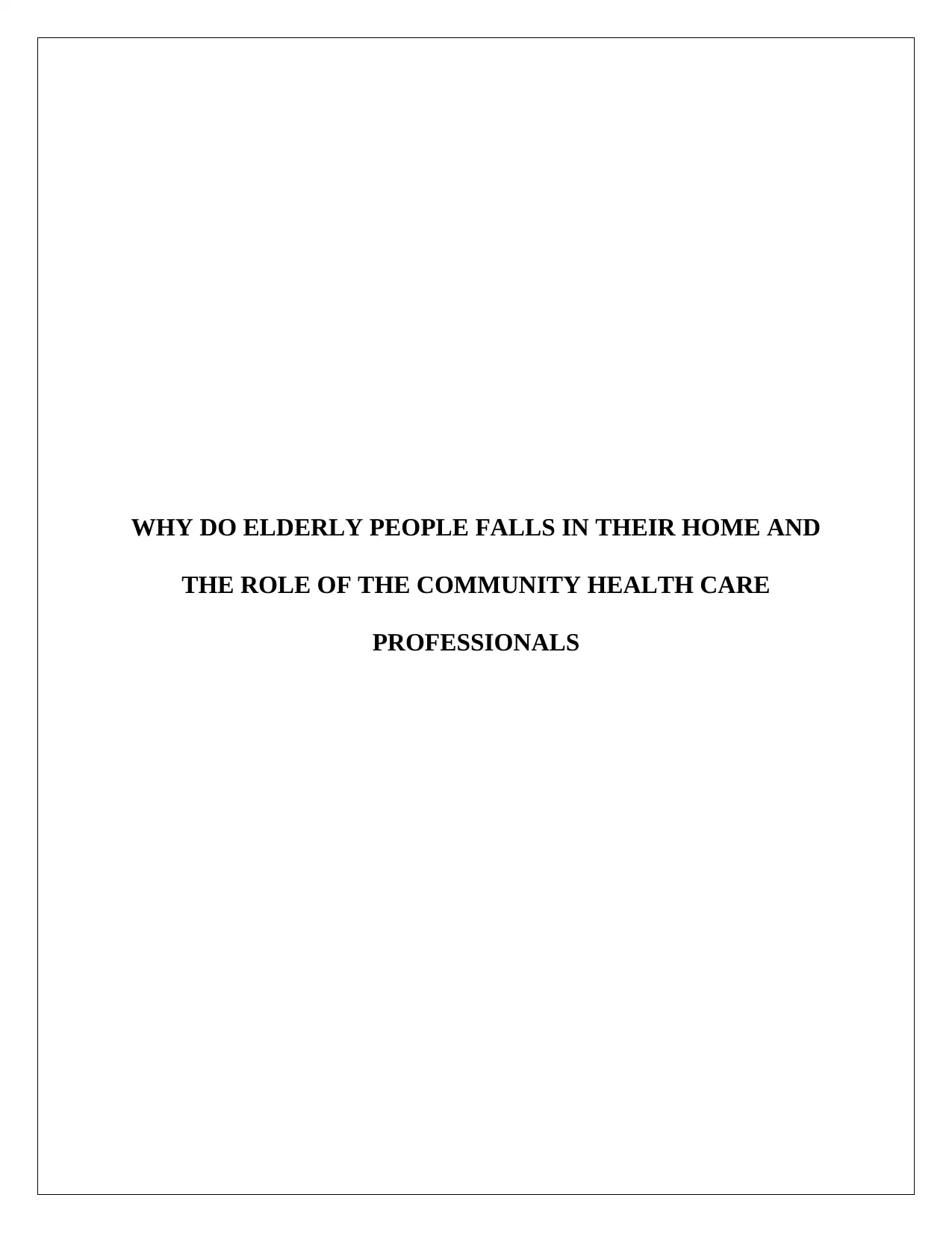
WHY DO ELDERLY PEOPLE FALLS IN THEIR HOME AND
THE ROLE OF THE COMMUNITY HEALTH CARE
PROFESSIONALS
THE ROLE OF THE COMMUNITY HEALTH CARE
PROFESSIONALS
Paraphrase This Document
Need a fresh take? Get an instant paraphrase of this document with our AI Paraphraser
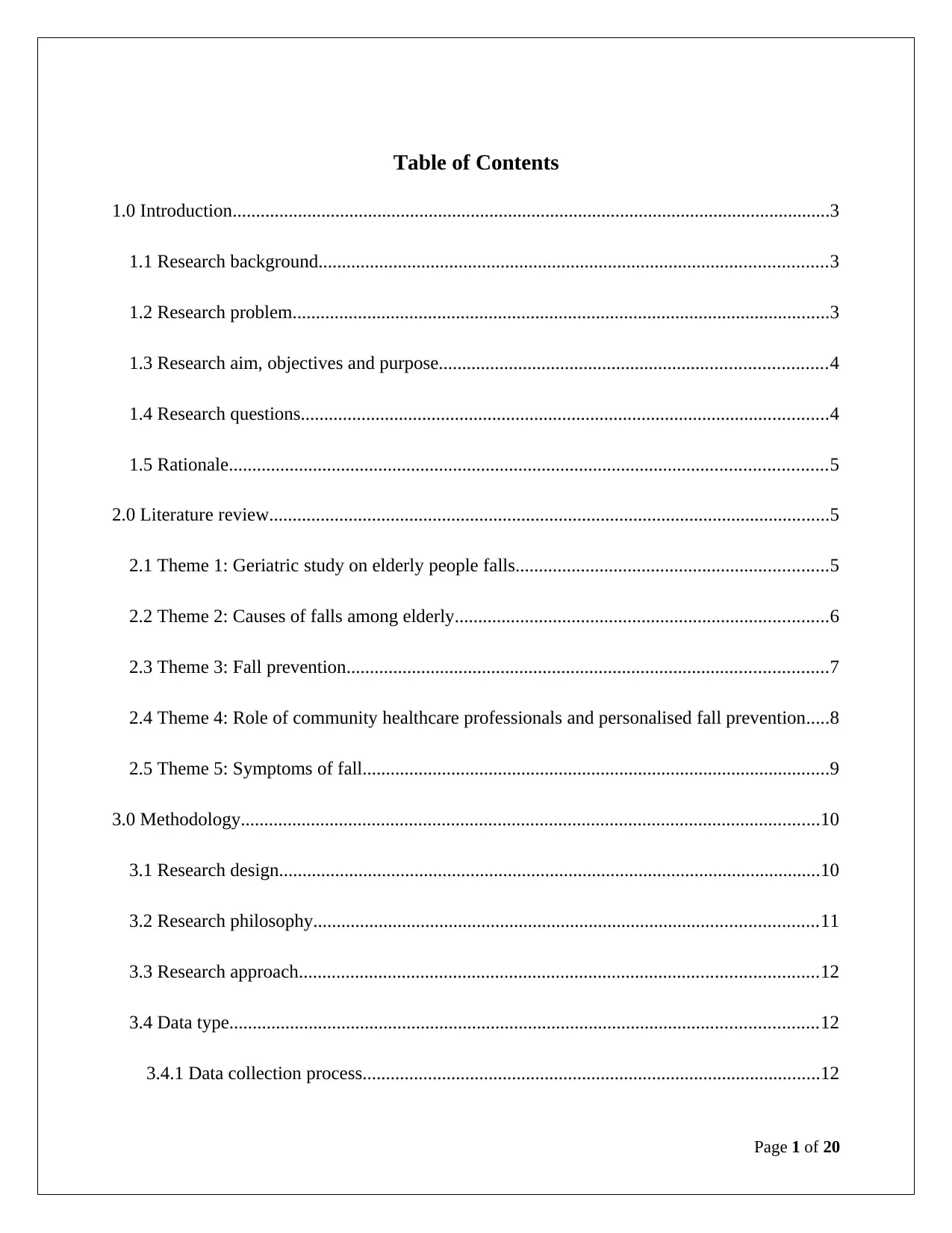
Table of Contents
1.0 Introduction................................................................................................................................3
1.1 Research background.............................................................................................................3
1.2 Research problem...................................................................................................................3
1.3 Research aim, objectives and purpose...................................................................................4
1.4 Research questions.................................................................................................................4
1.5 Rationale................................................................................................................................5
2.0 Literature review........................................................................................................................5
2.1 Theme 1: Geriatric study on elderly people falls...................................................................5
2.2 Theme 2: Causes of falls among elderly................................................................................6
2.3 Theme 3: Fall prevention.......................................................................................................7
2.4 Theme 4: Role of community healthcare professionals and personalised fall prevention.....8
2.5 Theme 5: Symptoms of fall....................................................................................................9
3.0 Methodology............................................................................................................................10
3.1 Research design....................................................................................................................10
3.2 Research philosophy............................................................................................................11
3.3 Research approach...............................................................................................................12
3.4 Data type..............................................................................................................................12
3.4.1 Data collection process..................................................................................................12
Page 1 of 20
1.0 Introduction................................................................................................................................3
1.1 Research background.............................................................................................................3
1.2 Research problem...................................................................................................................3
1.3 Research aim, objectives and purpose...................................................................................4
1.4 Research questions.................................................................................................................4
1.5 Rationale................................................................................................................................5
2.0 Literature review........................................................................................................................5
2.1 Theme 1: Geriatric study on elderly people falls...................................................................5
2.2 Theme 2: Causes of falls among elderly................................................................................6
2.3 Theme 3: Fall prevention.......................................................................................................7
2.4 Theme 4: Role of community healthcare professionals and personalised fall prevention.....8
2.5 Theme 5: Symptoms of fall....................................................................................................9
3.0 Methodology............................................................................................................................10
3.1 Research design....................................................................................................................10
3.2 Research philosophy............................................................................................................11
3.3 Research approach...............................................................................................................12
3.4 Data type..............................................................................................................................12
3.4.1 Data collection process..................................................................................................12
Page 1 of 20
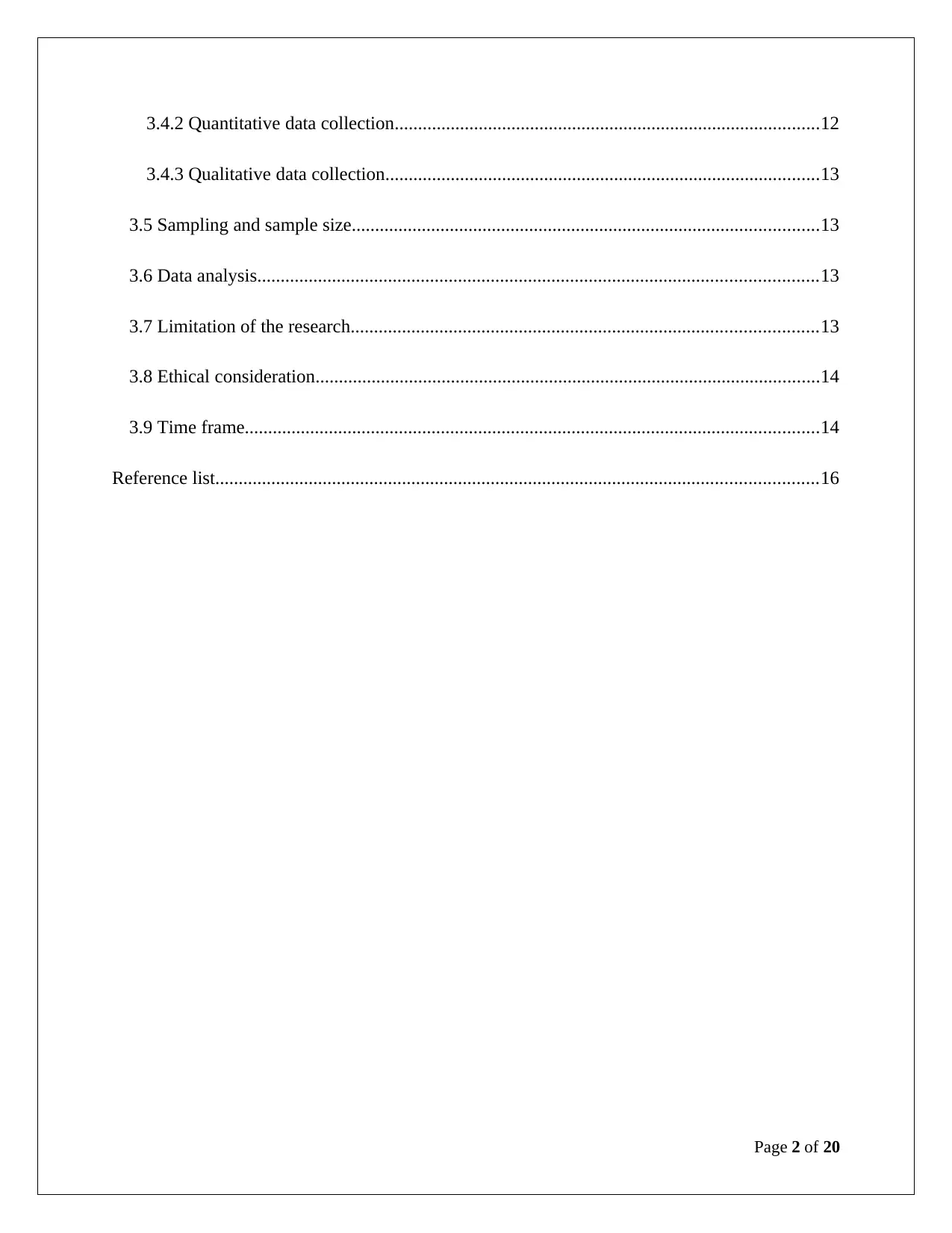
3.4.2 Quantitative data collection...........................................................................................12
3.4.3 Qualitative data collection.............................................................................................13
3.5 Sampling and sample size....................................................................................................13
3.6 Data analysis........................................................................................................................13
3.7 Limitation of the research....................................................................................................13
3.8 Ethical consideration............................................................................................................14
3.9 Time frame...........................................................................................................................14
Reference list.................................................................................................................................16
Page 2 of 20
3.4.3 Qualitative data collection.............................................................................................13
3.5 Sampling and sample size....................................................................................................13
3.6 Data analysis........................................................................................................................13
3.7 Limitation of the research....................................................................................................13
3.8 Ethical consideration............................................................................................................14
3.9 Time frame...........................................................................................................................14
Reference list.................................................................................................................................16
Page 2 of 20
⊘ This is a preview!⊘
Do you want full access?
Subscribe today to unlock all pages.

Trusted by 1+ million students worldwide
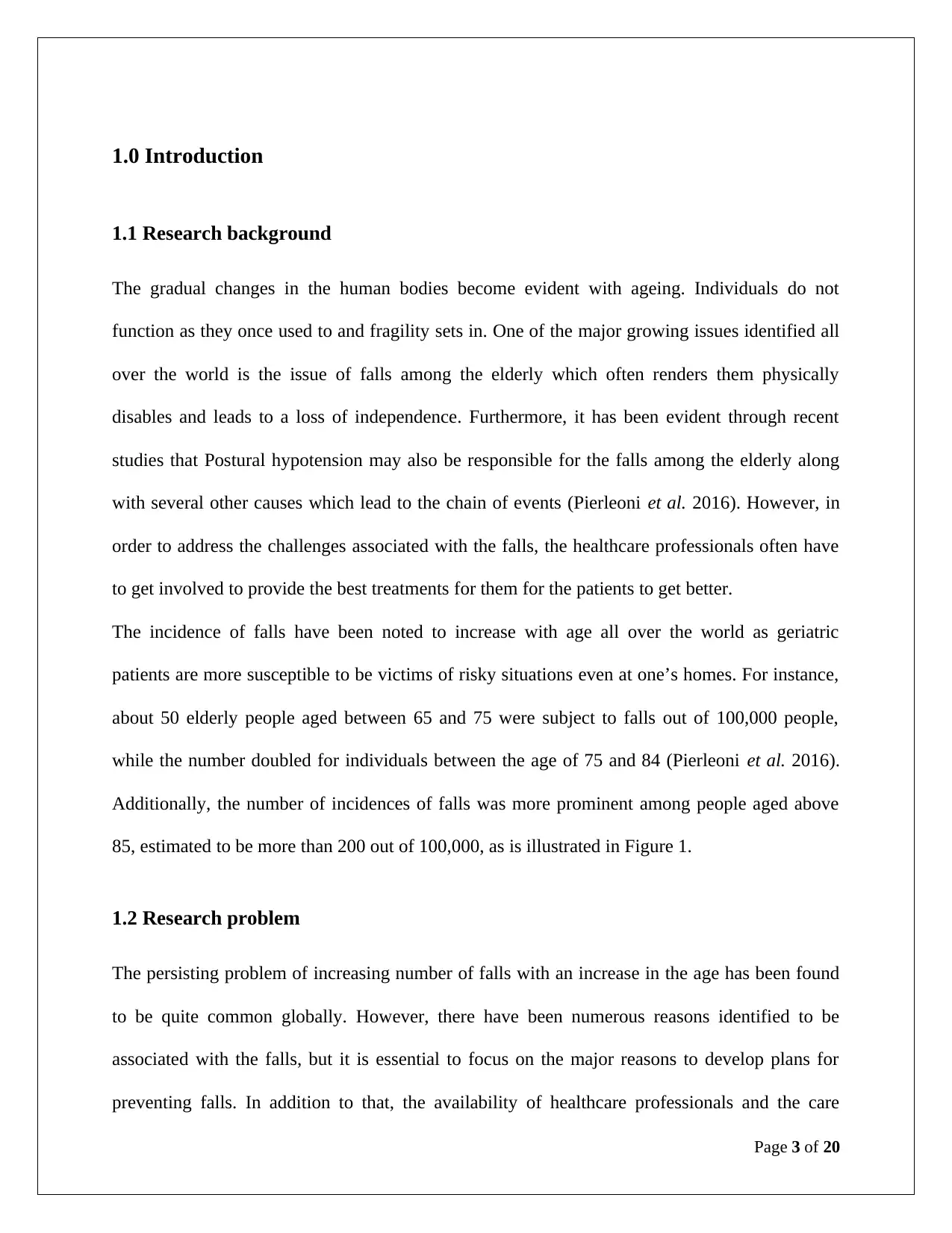
1.0 Introduction
1.1 Research background
The gradual changes in the human bodies become evident with ageing. Individuals do not
function as they once used to and fragility sets in. One of the major growing issues identified all
over the world is the issue of falls among the elderly which often renders them physically
disables and leads to a loss of independence. Furthermore, it has been evident through recent
studies that Postural hypotension may also be responsible for the falls among the elderly along
with several other causes which lead to the chain of events (Pierleoni et al. 2016). However, in
order to address the challenges associated with the falls, the healthcare professionals often have
to get involved to provide the best treatments for them for the patients to get better.
The incidence of falls have been noted to increase with age all over the world as geriatric
patients are more susceptible to be victims of risky situations even at one’s homes. For instance,
about 50 elderly people aged between 65 and 75 were subject to falls out of 100,000 people,
while the number doubled for individuals between the age of 75 and 84 (Pierleoni et al. 2016).
Additionally, the number of incidences of falls was more prominent among people aged above
85, estimated to be more than 200 out of 100,000, as is illustrated in Figure 1.
1.2 Research problem
The persisting problem of increasing number of falls with an increase in the age has been found
to be quite common globally. However, there have been numerous reasons identified to be
associated with the falls, but it is essential to focus on the major reasons to develop plans for
preventing falls. In addition to that, the availability of healthcare professionals and the care
Page 3 of 20
1.1 Research background
The gradual changes in the human bodies become evident with ageing. Individuals do not
function as they once used to and fragility sets in. One of the major growing issues identified all
over the world is the issue of falls among the elderly which often renders them physically
disables and leads to a loss of independence. Furthermore, it has been evident through recent
studies that Postural hypotension may also be responsible for the falls among the elderly along
with several other causes which lead to the chain of events (Pierleoni et al. 2016). However, in
order to address the challenges associated with the falls, the healthcare professionals often have
to get involved to provide the best treatments for them for the patients to get better.
The incidence of falls have been noted to increase with age all over the world as geriatric
patients are more susceptible to be victims of risky situations even at one’s homes. For instance,
about 50 elderly people aged between 65 and 75 were subject to falls out of 100,000 people,
while the number doubled for individuals between the age of 75 and 84 (Pierleoni et al. 2016).
Additionally, the number of incidences of falls was more prominent among people aged above
85, estimated to be more than 200 out of 100,000, as is illustrated in Figure 1.
1.2 Research problem
The persisting problem of increasing number of falls with an increase in the age has been found
to be quite common globally. However, there have been numerous reasons identified to be
associated with the falls, but it is essential to focus on the major reasons to develop plans for
preventing falls. In addition to that, the availability of healthcare professionals and the care
Page 3 of 20
Paraphrase This Document
Need a fresh take? Get an instant paraphrase of this document with our AI Paraphraser
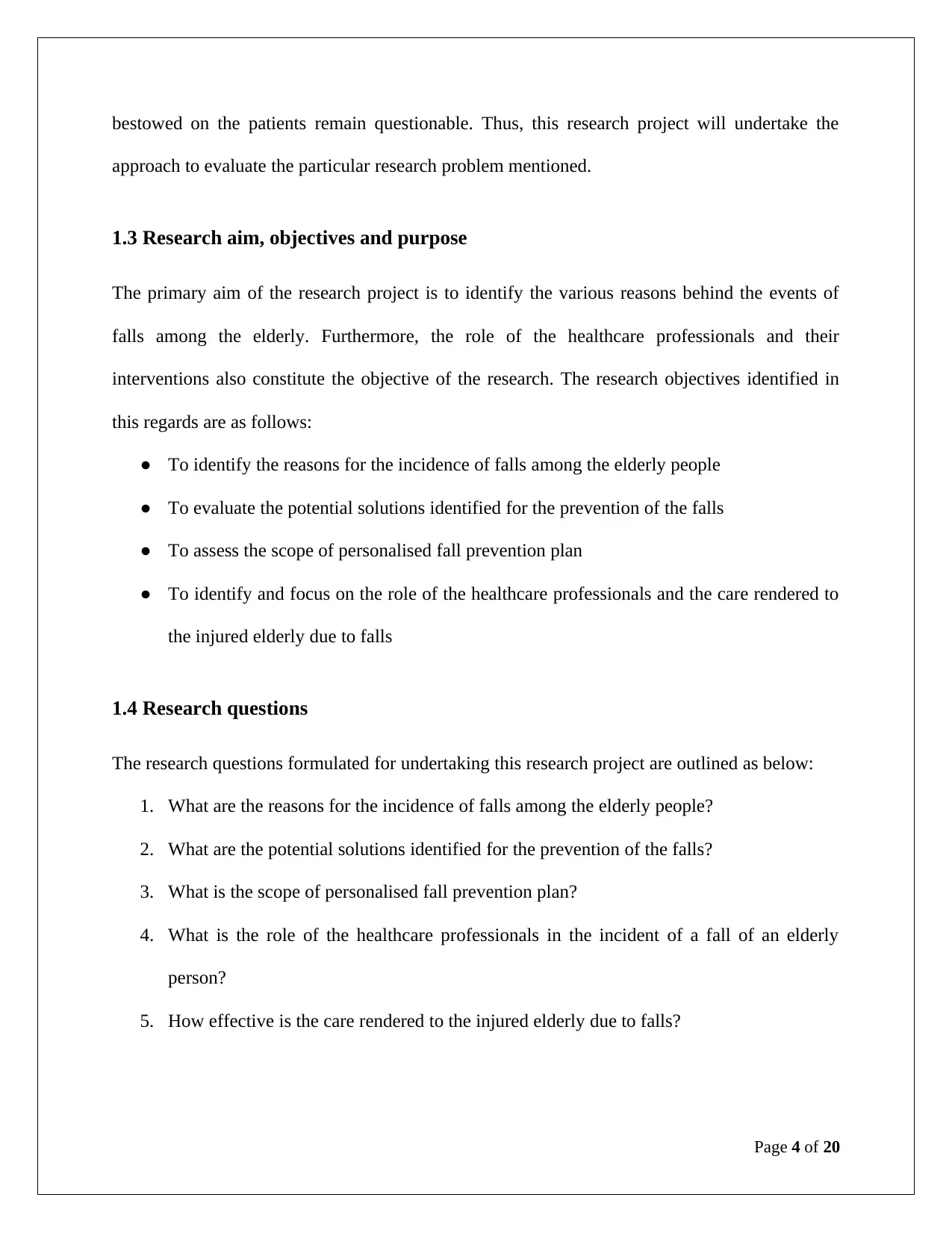
bestowed on the patients remain questionable. Thus, this research project will undertake the
approach to evaluate the particular research problem mentioned.
1.3 Research aim, objectives and purpose
The primary aim of the research project is to identify the various reasons behind the events of
falls among the elderly. Furthermore, the role of the healthcare professionals and their
interventions also constitute the objective of the research. The research objectives identified in
this regards are as follows:
● To identify the reasons for the incidence of falls among the elderly people
● To evaluate the potential solutions identified for the prevention of the falls
● To assess the scope of personalised fall prevention plan
● To identify and focus on the role of the healthcare professionals and the care rendered to
the injured elderly due to falls
1.4 Research questions
The research questions formulated for undertaking this research project are outlined as below:
1. What are the reasons for the incidence of falls among the elderly people?
2. What are the potential solutions identified for the prevention of the falls?
3. What is the scope of personalised fall prevention plan?
4. What is the role of the healthcare professionals in the incident of a fall of an elderly
person?
5. How effective is the care rendered to the injured elderly due to falls?
Page 4 of 20
approach to evaluate the particular research problem mentioned.
1.3 Research aim, objectives and purpose
The primary aim of the research project is to identify the various reasons behind the events of
falls among the elderly. Furthermore, the role of the healthcare professionals and their
interventions also constitute the objective of the research. The research objectives identified in
this regards are as follows:
● To identify the reasons for the incidence of falls among the elderly people
● To evaluate the potential solutions identified for the prevention of the falls
● To assess the scope of personalised fall prevention plan
● To identify and focus on the role of the healthcare professionals and the care rendered to
the injured elderly due to falls
1.4 Research questions
The research questions formulated for undertaking this research project are outlined as below:
1. What are the reasons for the incidence of falls among the elderly people?
2. What are the potential solutions identified for the prevention of the falls?
3. What is the scope of personalised fall prevention plan?
4. What is the role of the healthcare professionals in the incident of a fall of an elderly
person?
5. How effective is the care rendered to the injured elderly due to falls?
Page 4 of 20
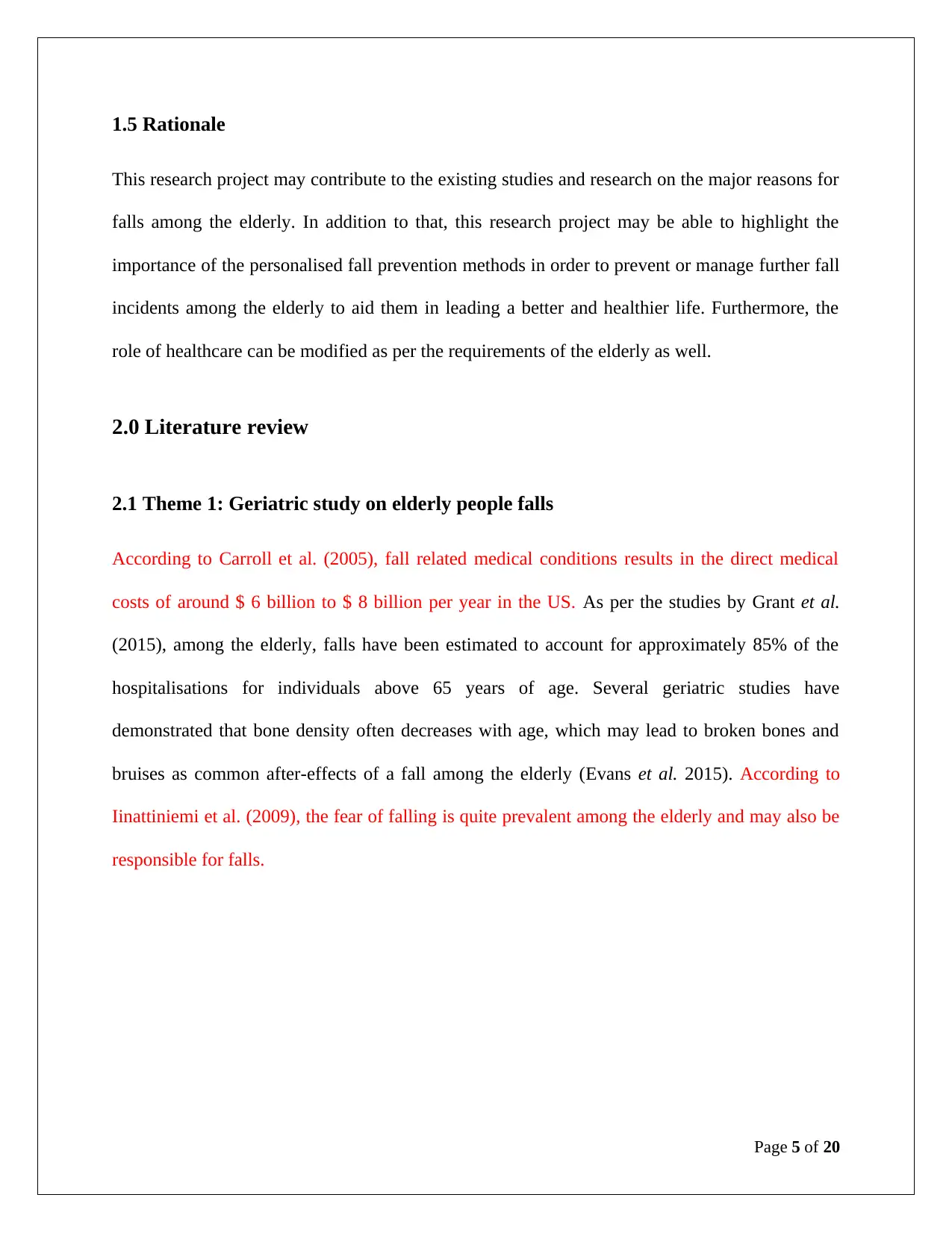
1.5 Rationale
This research project may contribute to the existing studies and research on the major reasons for
falls among the elderly. In addition to that, this research project may be able to highlight the
importance of the personalised fall prevention methods in order to prevent or manage further fall
incidents among the elderly to aid them in leading a better and healthier life. Furthermore, the
role of healthcare can be modified as per the requirements of the elderly as well.
2.0 Literature review
2.1 Theme 1: Geriatric study on elderly people falls
According to Carroll et al. (2005), fall related medical conditions results in the direct medical
costs of around $ 6 billion to $ 8 billion per year in the US. As per the studies by Grant et al.
(2015), among the elderly, falls have been estimated to account for approximately 85% of the
hospitalisations for individuals above 65 years of age. Several geriatric studies have
demonstrated that bone density often decreases with age, which may lead to broken bones and
bruises as common after-effects of a fall among the elderly (Evans et al. 2015). According to
Iinattiniemi et al. (2009), the fear of falling is quite prevalent among the elderly and may also be
responsible for falls.
Page 5 of 20
This research project may contribute to the existing studies and research on the major reasons for
falls among the elderly. In addition to that, this research project may be able to highlight the
importance of the personalised fall prevention methods in order to prevent or manage further fall
incidents among the elderly to aid them in leading a better and healthier life. Furthermore, the
role of healthcare can be modified as per the requirements of the elderly as well.
2.0 Literature review
2.1 Theme 1: Geriatric study on elderly people falls
According to Carroll et al. (2005), fall related medical conditions results in the direct medical
costs of around $ 6 billion to $ 8 billion per year in the US. As per the studies by Grant et al.
(2015), among the elderly, falls have been estimated to account for approximately 85% of the
hospitalisations for individuals above 65 years of age. Several geriatric studies have
demonstrated that bone density often decreases with age, which may lead to broken bones and
bruises as common after-effects of a fall among the elderly (Evans et al. 2015). According to
Iinattiniemi et al. (2009), the fear of falling is quite prevalent among the elderly and may also be
responsible for falls.
Page 5 of 20
⊘ This is a preview!⊘
Do you want full access?
Subscribe today to unlock all pages.

Trusted by 1+ million students worldwide
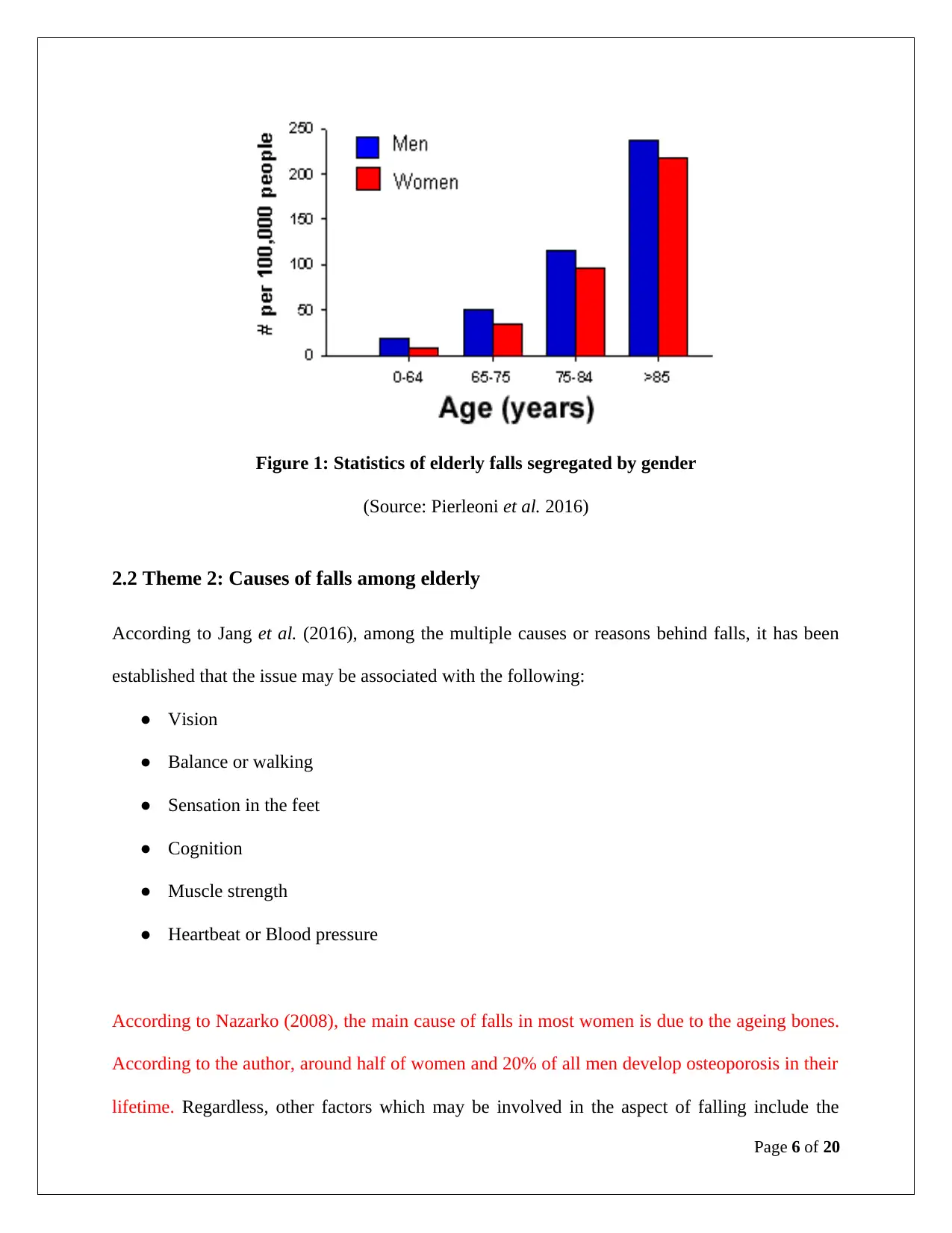
Figure 1: Statistics of elderly falls segregated by gender
(Source: Pierleoni et al. 2016)
2.2 Theme 2: Causes of falls among elderly
According to Jang et al. (2016), among the multiple causes or reasons behind falls, it has been
established that the issue may be associated with the following:
● Vision
● Balance or walking
● Sensation in the feet
● Cognition
● Muscle strength
● Heartbeat or Blood pressure
According to Nazarko (2008), the main cause of falls in most women is due to the ageing bones.
According to the author, around half of women and 20% of all men develop osteoporosis in their
lifetime. Regardless, other factors which may be involved in the aspect of falling include the
Page 6 of 20
(Source: Pierleoni et al. 2016)
2.2 Theme 2: Causes of falls among elderly
According to Jang et al. (2016), among the multiple causes or reasons behind falls, it has been
established that the issue may be associated with the following:
● Vision
● Balance or walking
● Sensation in the feet
● Cognition
● Muscle strength
● Heartbeat or Blood pressure
According to Nazarko (2008), the main cause of falls in most women is due to the ageing bones.
According to the author, around half of women and 20% of all men develop osteoporosis in their
lifetime. Regardless, other factors which may be involved in the aspect of falling include the
Page 6 of 20
Paraphrase This Document
Need a fresh take? Get an instant paraphrase of this document with our AI Paraphraser
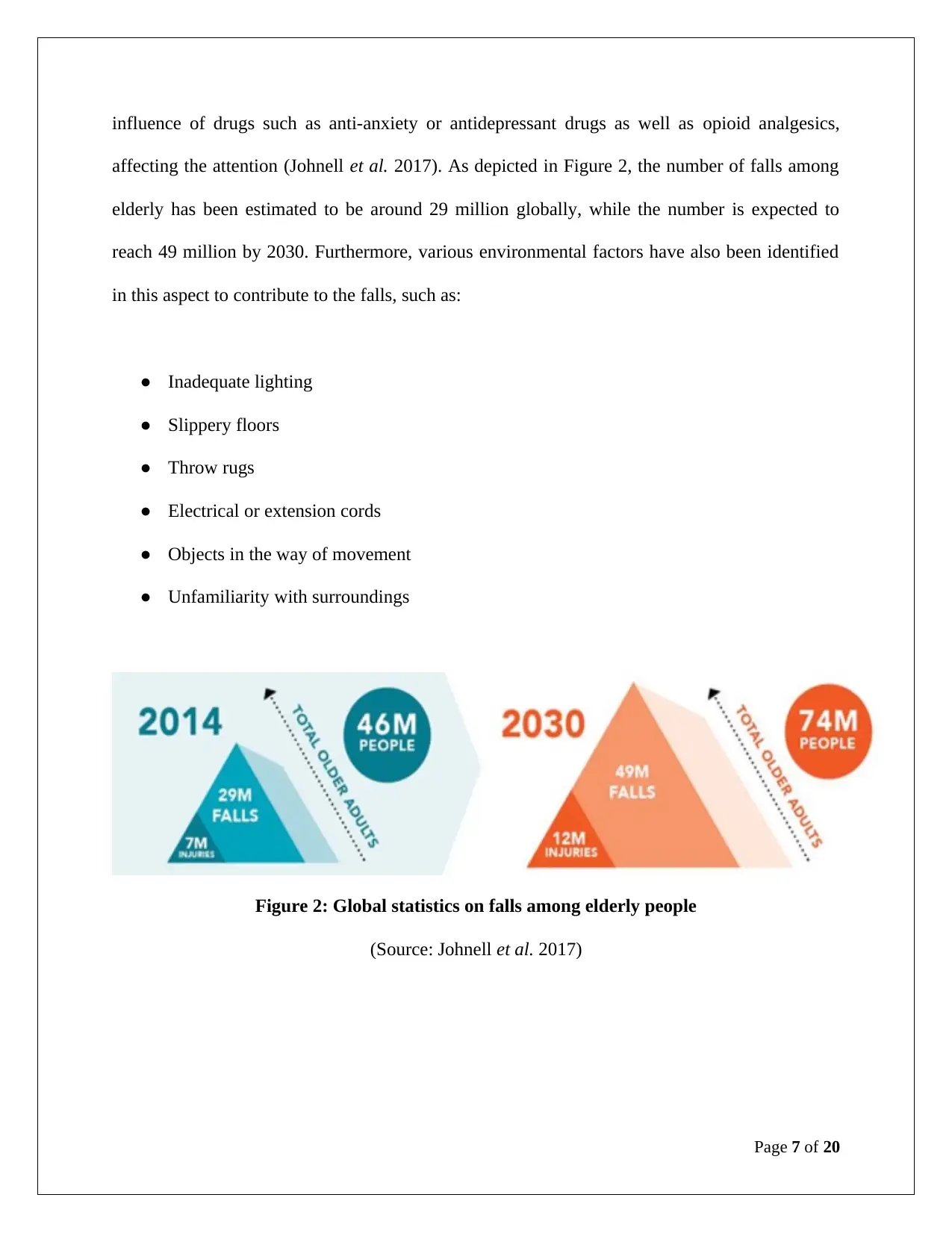
influence of drugs such as anti-anxiety or antidepressant drugs as well as opioid analgesics,
affecting the attention (Johnell et al. 2017). As depicted in Figure 2, the number of falls among
elderly has been estimated to be around 29 million globally, while the number is expected to
reach 49 million by 2030. Furthermore, various environmental factors have also been identified
in this aspect to contribute to the falls, such as:
● Inadequate lighting
● Slippery floors
● Throw rugs
● Electrical or extension cords
● Objects in the way of movement
● Unfamiliarity with surroundings
Figure 2: Global statistics on falls among elderly people
(Source: Johnell et al. 2017)
Page 7 of 20
affecting the attention (Johnell et al. 2017). As depicted in Figure 2, the number of falls among
elderly has been estimated to be around 29 million globally, while the number is expected to
reach 49 million by 2030. Furthermore, various environmental factors have also been identified
in this aspect to contribute to the falls, such as:
● Inadequate lighting
● Slippery floors
● Throw rugs
● Electrical or extension cords
● Objects in the way of movement
● Unfamiliarity with surroundings
Figure 2: Global statistics on falls among elderly people
(Source: Johnell et al. 2017)
Page 7 of 20

2.3 Theme 3: Fall prevention
Checking the area or the accommodation facilities of the elderly by family or care providers is of
utmost importance in this regards. According to Nazarko (2012), check-ups at regular intervals
are essential to note the health conditions such as heartbeat, blood pressure, vision accuracy and
more. Elderly individuals living alone may be accompanied by care providers, especially the
ones who are under the influence of certain drugs which may affect the attention span and reduce
focus of the elderly people (Tricco et al. 2017). Figure 3 outlines the outcomes of falls among
individuals above the age of 65 years, and it is evident that about 1.6 million elderly people have
been under treatment for falling.
Figure 3: Fatal and non-fatal injury percentage among the elderly
(Source: Quach and Burr, 2018)
2.4 Theme 4: Role of community healthcare professionals and personalised fall
prevention
It may be stated in this context that it is essential to perform a risk evaluation assessment in
which the risks of falling is ascertained for a given individual, considering risk factors such as
Page 8 of 20
Checking the area or the accommodation facilities of the elderly by family or care providers is of
utmost importance in this regards. According to Nazarko (2012), check-ups at regular intervals
are essential to note the health conditions such as heartbeat, blood pressure, vision accuracy and
more. Elderly individuals living alone may be accompanied by care providers, especially the
ones who are under the influence of certain drugs which may affect the attention span and reduce
focus of the elderly people (Tricco et al. 2017). Figure 3 outlines the outcomes of falls among
individuals above the age of 65 years, and it is evident that about 1.6 million elderly people have
been under treatment for falling.
Figure 3: Fatal and non-fatal injury percentage among the elderly
(Source: Quach and Burr, 2018)
2.4 Theme 4: Role of community healthcare professionals and personalised fall
prevention
It may be stated in this context that it is essential to perform a risk evaluation assessment in
which the risks of falling is ascertained for a given individual, considering risk factors such as
Page 8 of 20
⊘ This is a preview!⊘
Do you want full access?
Subscribe today to unlock all pages.

Trusted by 1+ million students worldwide
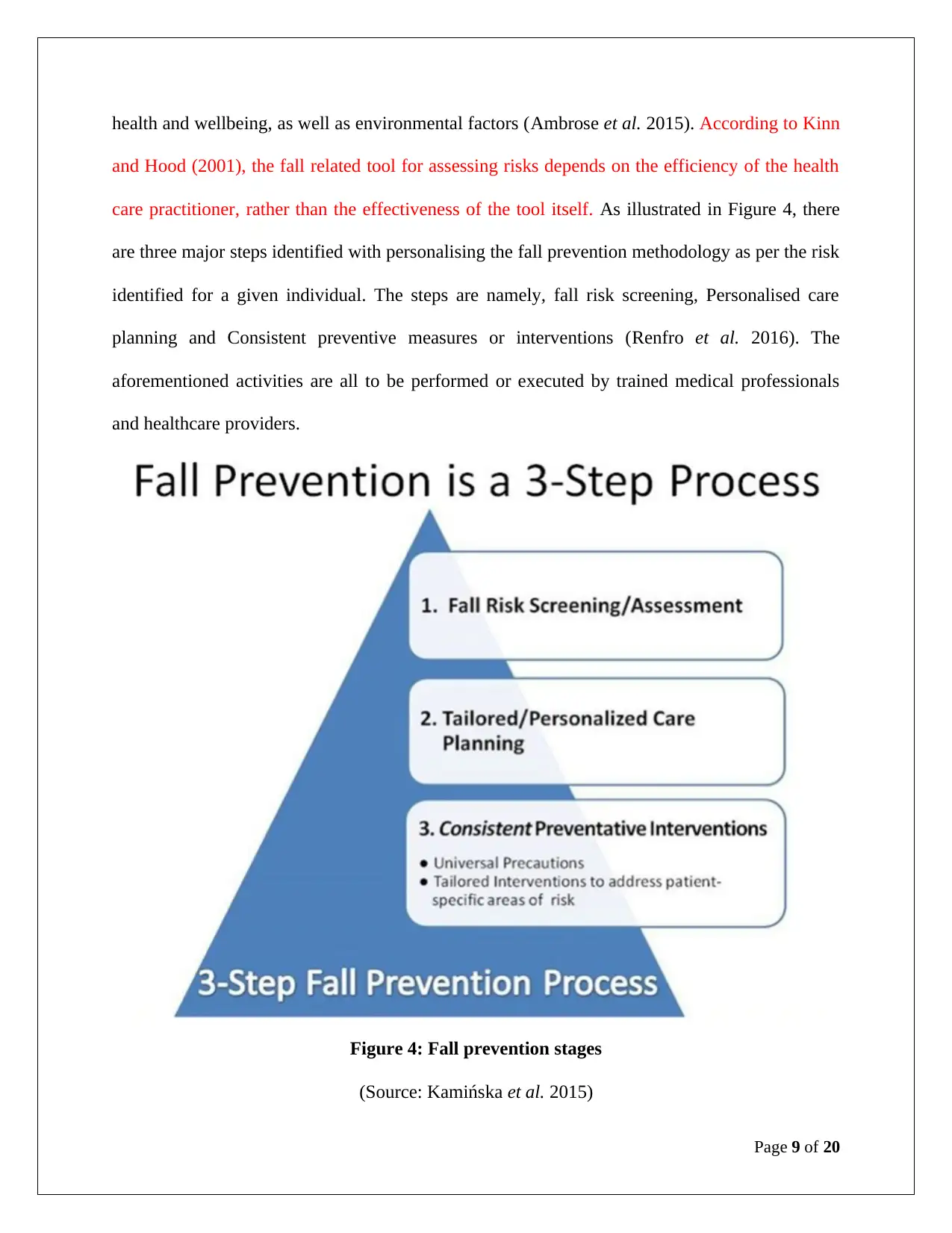
health and wellbeing, as well as environmental factors (Ambrose et al. 2015). According to Kinn
and Hood (2001), the fall related tool for assessing risks depends on the efficiency of the health
care practitioner, rather than the effectiveness of the tool itself. As illustrated in Figure 4, there
are three major steps identified with personalising the fall prevention methodology as per the risk
identified for a given individual. The steps are namely, fall risk screening, Personalised care
planning and Consistent preventive measures or interventions (Renfro et al. 2016). The
aforementioned activities are all to be performed or executed by trained medical professionals
and healthcare providers.
Figure 4: Fall prevention stages
(Source: Kamińska et al. 2015)
Page 9 of 20
and Hood (2001), the fall related tool for assessing risks depends on the efficiency of the health
care practitioner, rather than the effectiveness of the tool itself. As illustrated in Figure 4, there
are three major steps identified with personalising the fall prevention methodology as per the risk
identified for a given individual. The steps are namely, fall risk screening, Personalised care
planning and Consistent preventive measures or interventions (Renfro et al. 2016). The
aforementioned activities are all to be performed or executed by trained medical professionals
and healthcare providers.
Figure 4: Fall prevention stages
(Source: Kamińska et al. 2015)
Page 9 of 20
Paraphrase This Document
Need a fresh take? Get an instant paraphrase of this document with our AI Paraphraser

2.5 Theme 5: Symptoms of fall
Figure 5 demonstrates that approximately half of the falls which occur to elderly people occur at
their own homes. It is essential to study the symptoms which may indicate the patient being in an
event of a fall, as the elderly often do not disclose such accidents. Furthermore, there may be
symptoms to be identified prior to the events which may prepare people for the likelihood of the
event. For instance, the occurrence of light-headedness, dizziness as well as palpitations may be
related to the incidents of falls among the elderly (Okubo et al. 2015).
Figure 5: Locations of falls of elderly people
(Source: Kvelde et al. 2015)
3.0 Methodology
3.1 Research design
A descriptive research design is chosen for this particular research project as it implements the
use of surveys as primary data sources and case studies from secondary sources to investigate the
Page 10 of 20
Figure 5 demonstrates that approximately half of the falls which occur to elderly people occur at
their own homes. It is essential to study the symptoms which may indicate the patient being in an
event of a fall, as the elderly often do not disclose such accidents. Furthermore, there may be
symptoms to be identified prior to the events which may prepare people for the likelihood of the
event. For instance, the occurrence of light-headedness, dizziness as well as palpitations may be
related to the incidents of falls among the elderly (Okubo et al. 2015).
Figure 5: Locations of falls of elderly people
(Source: Kvelde et al. 2015)
3.0 Methodology
3.1 Research design
A descriptive research design is chosen for this particular research project as it implements the
use of surveys as primary data sources and case studies from secondary sources to investigate the
Page 10 of 20

issue (Teherani et al. 2015). As illustrated in Figure 6, the research onion by Saunders et al.
(2015), demonstrates the various approaches, philosophies which are most suited to different
research projects.
Figure 6: Research onion
(Source: Saunders et al. 2015)
3.2 Research philosophy
The research philosophy to be chosen for this research is positivism to justify the scientific
approach as exhibited in the quantitative analysis, while an interpretivism philosophy can be
implemented for the qualitative research. Positivism in this regards can be used to justify the
statistical representations to be made to demonstrate the findings from the quantitative analysis
of the survey data (Jackson, 2015). On the contrary, the interpretivism philosophy can be
Page 11 of 20
(2015), demonstrates the various approaches, philosophies which are most suited to different
research projects.
Figure 6: Research onion
(Source: Saunders et al. 2015)
3.2 Research philosophy
The research philosophy to be chosen for this research is positivism to justify the scientific
approach as exhibited in the quantitative analysis, while an interpretivism philosophy can be
implemented for the qualitative research. Positivism in this regards can be used to justify the
statistical representations to be made to demonstrate the findings from the quantitative analysis
of the survey data (Jackson, 2015). On the contrary, the interpretivism philosophy can be
Page 11 of 20
⊘ This is a preview!⊘
Do you want full access?
Subscribe today to unlock all pages.

Trusted by 1+ million students worldwide
1 out of 20
Related Documents
Your All-in-One AI-Powered Toolkit for Academic Success.
+13062052269
info@desklib.com
Available 24*7 on WhatsApp / Email
![[object Object]](/_next/static/media/star-bottom.7253800d.svg)
Unlock your academic potential
Copyright © 2020–2025 A2Z Services. All Rights Reserved. Developed and managed by ZUCOL.





